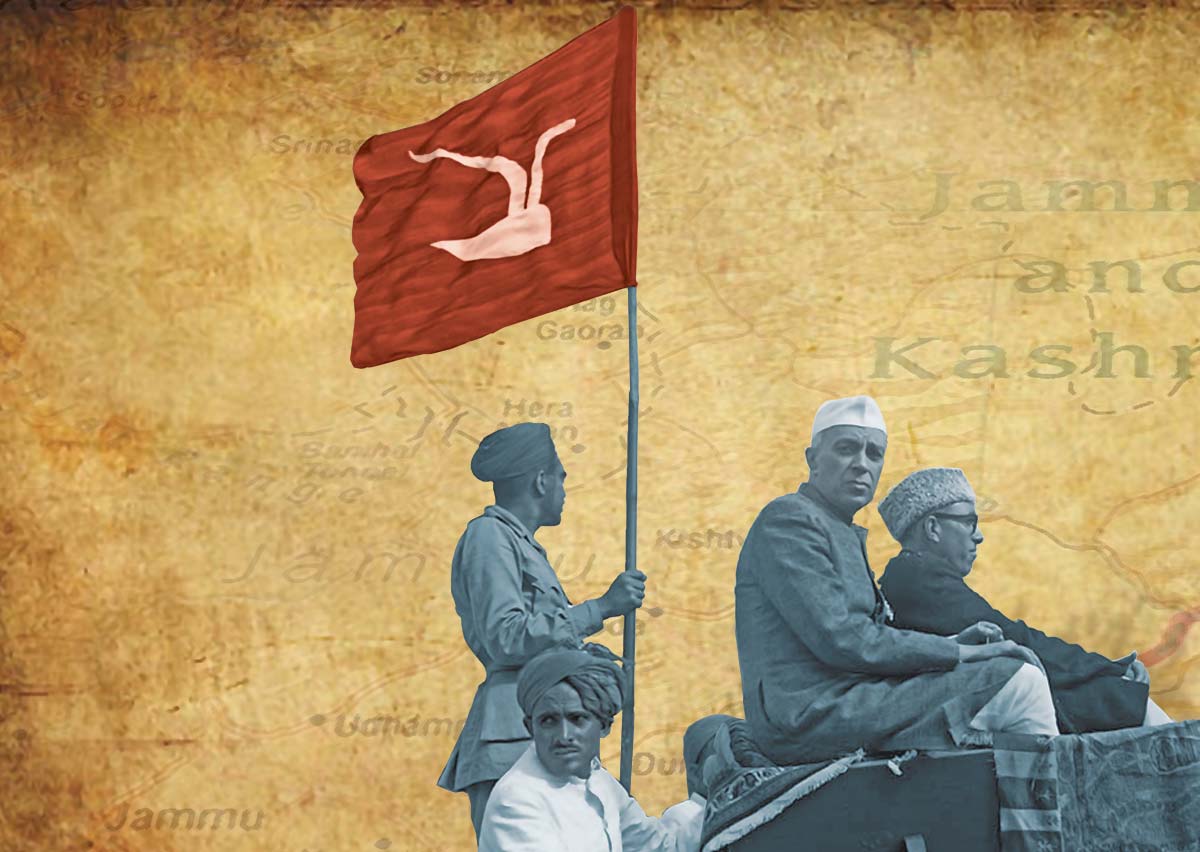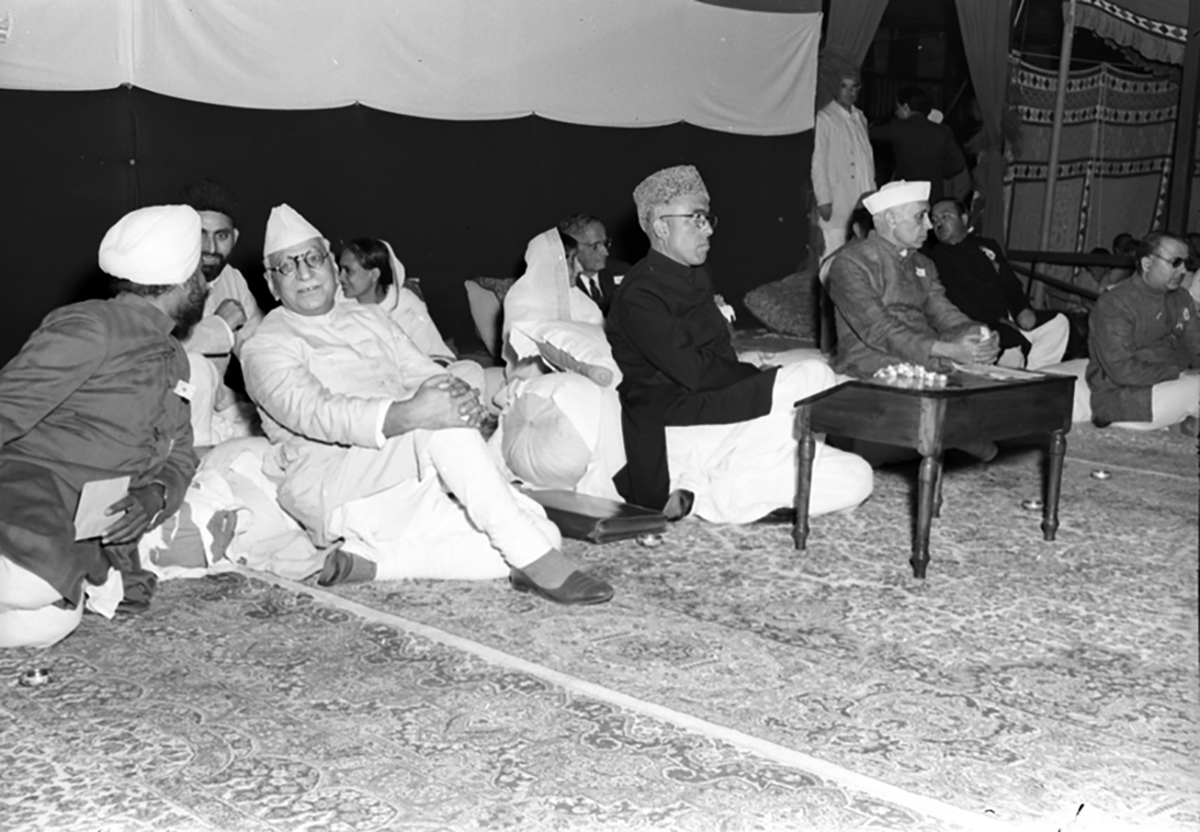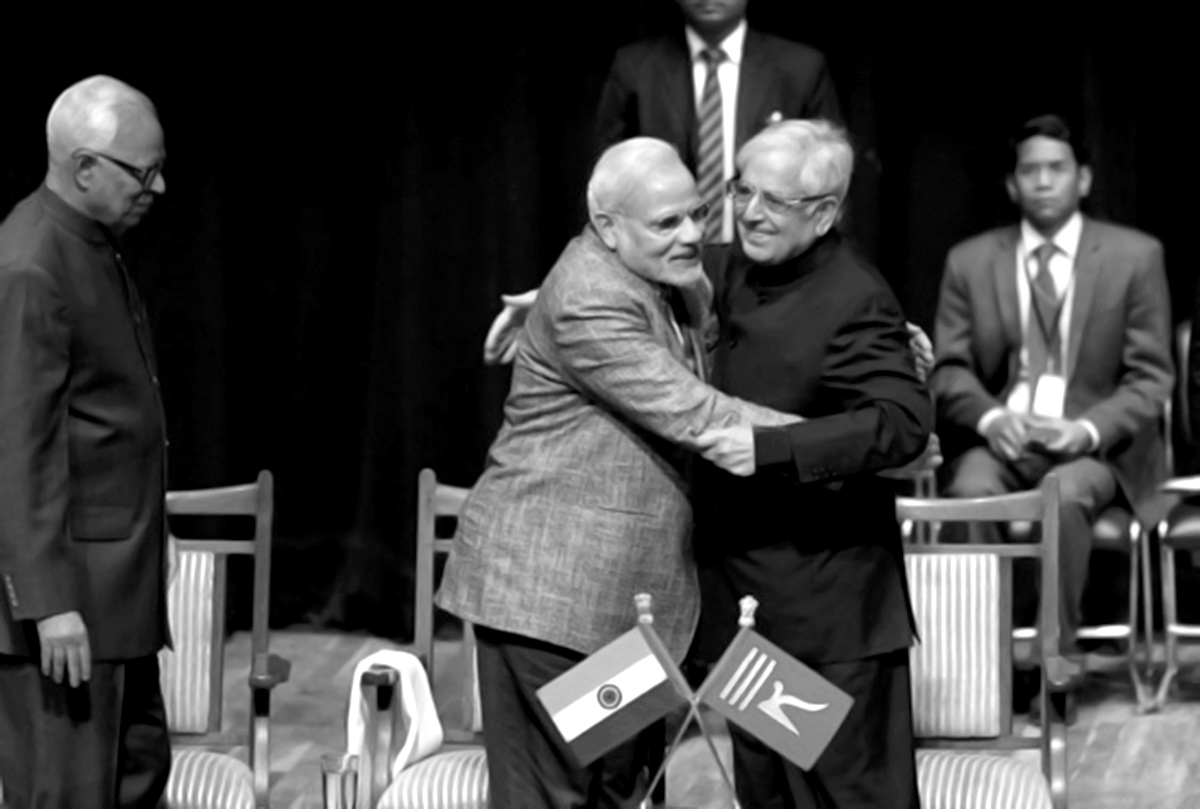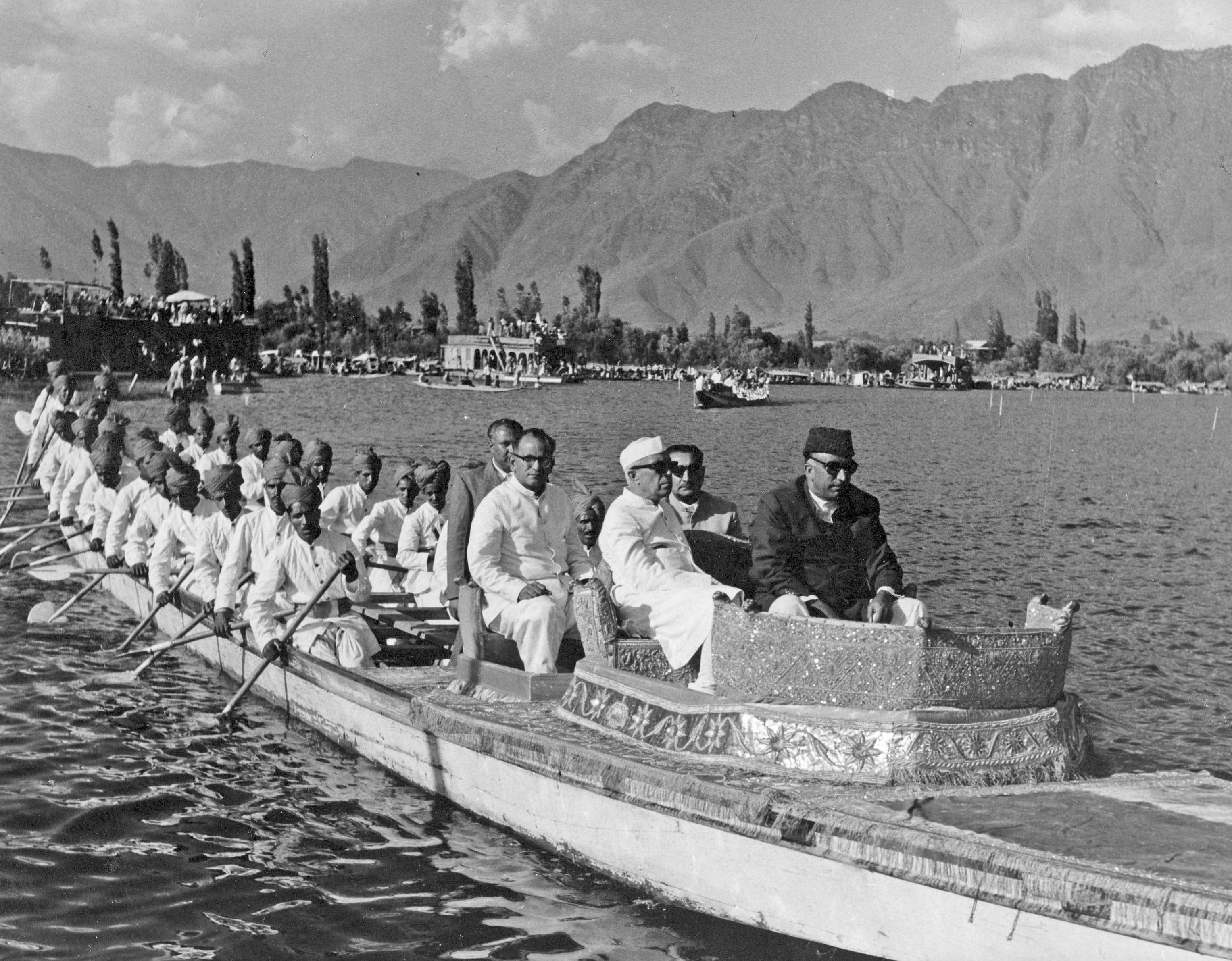If BJP undoes its erstwhile ally, the PDP in Kashmir, it may not be happening for the first time. A year after the Delhi agreement, Nehru’s Congress deposed Sheikh Abdullah in August 1953, jailed him, and wrested his National Conference till it merged with Congress. B P Sharma details the historic conversion, and how Sheikh reclaimed NC after becoming de facto head of the Congress

The formal induction of the Indian National Congress (INC) in Jammu and Kashmir on January 26, 1965, was a landmark in the political history of the State. (It may be mentioned here that as early as 1938 late Khwaja Mohammad Umar Bhat and Pandit Raghunath Vaishnavi, a young advocate, had established the Kashmir National Congress in Srinagar. But it was not recognized by AICC).
This was, in fact, the third in the series of political decisions taken by the people of the Valley of Kashmir which shaped their destiny. The first was the formation of the Muslim Conference in 1931. The second significant step towards bringing the people of the State closer to the national mainstream was the conversion of the Muslim Conference into Jammu and Kashmir National Conference, the membership of which was thrown open to all communities. It was in the course of the struggle for securing their democratic rights and especially during the historic Quit Kashmir Movement, started by Sheikh Mohammed Abdullah in 1946, that the top national leaders of the INC like Mahatma Gandhi and Pandit Jawahar Lal Nehru personally came to Kashmir to support the cause of the people. Nehru was even arrested at Kohala and prevented to reach Srinagar.
In sharp contrast with the support and sympathy given by the Congress, the Muslim League led by Jinnah remained openly hostile to the struggle of the people of Kashmir against the autocratic rule. This strengthened the belief of the people of Kashmir that they could achieve their goal only by joining the mainstream of the nationalist movement of the country. This ultimately resulted in the rejection of Jinnah’s two-nation theory and accession with India in 1947.
Between 1947 and 1953 some further constitutional measures were adopted to bring the State closer to Union, but Sheikh Abdullah being a staunch advocate for preserving the identity of the State within the Indian Union got Article 370 included in the Constitution.
Soon after the arrest of Sheikh Abdullah and dismissal of his ministry in 1953 in a most undemocratic and unconstitutional manner, a chapter of political corruption began in the State as also in the National Conference ranks itself. A vote of confidence had to be obtained by Bakshi Ghulam Mohammad which necessitated “winning over” of the majority of the members of the legislature. Three options were open.
The first to accept the “terms” offered by Bakhshi, the second was to face the inhuman methods of torture adopted by Ganderbali in the Kothi Bagh Police Station and the third was the Central jail.
The BBC (as the Bakhshi Brothers Corporation was called) exploited the situation to its own advantage. The National Conference totally lost the credibility and the prestige it had built under the leadership of Sheikh Mohammad Abdullah.
With the appointment of Khwaja Ghulam Mohammad Sadiq as the Prime Minister of the State in 1964, a new era of bringing the Jammu and Kashmir State closer to the Union constitutionally, the first step Sadiq took was an amendment in the State Constitution whereby the designation of the Prime Minister was changed to Chief Minister and that of the Sadar-i-Riyasat to Governor. This brought Jammu and Kashmir at par with the other States in the country. The list of Central laws made applicable to the State during Sadiq’s time is very large. The most important contribution he made was the induction of the Indian National Congress in the State. Among other leaders who worked hard for bringing about this change, mention may be made of Syed Mir Qasim, Pandit Trilochan Dutt, D P Dhar, Mohammad Shafi Qureshi and Ghulam Rasool Kar.
Special Convention
A special Convention of the National Conference was called in July 1964. The causes of the decay of the Party were analyzed and a unanimous resolution was adopted to convert it into a full-fledged unit of the INC.
On July 18, 1964, the Working Committee of the National Conference empowered Sadiq to discuss with Kamraj and Lal Bahadur Shastri the need and desirability of the merger of the National Conference with the INC. This was followed by endorsement of this decision by a Convention held at Jammu. Earlier, Mohammad Shafi Qureshi had taken the initiative of establishing what was known as the City Indian Congress. He accepted merger of his party with the National Conference on August 5, 1964.
In the meantime, Syed Mir Qasim and Pandit Trilochan Dutt resigned from the Government to take up the organizational work in Kashmir and Jammu respectively. They made extensive tours to educate public opinion in favour of the new political programme.
Durgapur Session

Prominent leaders, including MPs and MLAs of the National Conference, attended the Durgapur Session of the INC in January 1965. They requested Lal Bahadur Shastri to accept their demand for converting the National Conference into Pradesh Congress Committee. On January 7, 1965, a resolution was adopted at the Session authorizing setting up of the Congress in Jammu and Kashmir. Simultaneously Syed Mir Qasim was nominated as its Founder President.
The Birth Pangs
Syed Mir Qasim fixed the Republic Day January 26, 1965, as the date to begin enrolment of members and Khwaja Ghulam Mohammad Sadiq was the first to sign the form of Congress membership. After this, enrolment began throughout the State. Thus the Jammu and Kashmir
National Conference got merged into the INC.
In the Valley of Kashmir, the new political change met with bitter opposition. With the blessings of Sheikh Mohammad Abdullah, Mirza Mohammad Afzal Beg had formed a Plebiscite Front. At the very outset, a campaign of social boycott known as Tarak-i-Mualat was launched by the separatist elements to intimidate and harass the Congress workers. Syed Mir Qasim in his autobiography Dastan-i-Hayat has given some harrowing details of the hardships the Congress workers had to suffer on account of Sheikh Mohammad Abdullah’s call for a social boycott.
Pakistan Attack
Obviously, Pakistan got misleading signals about the popularity of the Plebiscite Front in the Valley at that time and in the mistaken hope of receiving support from the local population, launched a full-fledged armed campaign in August 1965. This was a supreme test for the newly formed Congress and its top leaders. However, Congress workers rendered useful assistance to the security forces and saved the Valley of Kashmir from destruction.
With a larger common border with Pakistan, Jammu suffered large-scale destruction. Relief Camps had to be organized for the refugees and their rehabilitation afterwards was also a gigantic task. However, credit goes to the dedicated Congress leaders who undertook intensive tours to restore confidence among the people. Pakistan lost the game.
Home Minister’s Visit
In June 1966, the Union Home Minister, Gulzari Lal Nanda, addressed a Convention of the Congress workers at Bijbihara in the Valley of Kashmir. He declared amidst cheers “the decision taken by the people of the State to accede to India is not an accidental act. It is the logical outcome of the national movement of Kashmir. Your national movement had developed in the course of its struggle against autocracy. During this struggle, a relationship based on common ideals of secularism and democracy was born between the Kashmiris and people in the rest of the country. This relationship is eternal and no power on earth can hamper it. The course of history cannot be changed.”
Reviewing the conflict with Pakistan, the Convention passed a resolution congratulating the people of the State who successfully foiled the attempts of Pakistan to annex Jammu and Kashmir State by force, it said:
“While the need for unity is imperative, the Convention feels that the Congress Party in Jammu and Kashmir should alert the people against unhealthy and disruptive tendencies which tend to weaken the people’s resolve to live in kinship with their brethren in the rest of India. While the rights and opportunities guaranteed in the Constitution should become a reality for the common man, the State cannot afford to shelter anti-national and anti-social elements. Such elements should be isolated and dealt with sternly.”
Victory For Congress
The popularity which the Congress gained in the valley of Kashmir in particular, may be judged from the results of the State Legislative assembly elections in 1967. The Congress bagged 35 out of 42 seats in Kashmir region, 25 out of 31 seats in Jammu region and 2 out of 2 seats in Ladakh, making a total of 62 out of 75 seats in the Legislature. The National Conference won 3 seats and the Jana Sangh 4 seats, 3 seats remained vacant and the rest were won by independents.
Bakhshi Joins Congres
Sensing that his future lay in strengthening the Congress, even Bakhshi Ghulam Mohammad merged his National Conference with the Congress. The PCC welcomed this step and nominated Bakhshi Ghulam Mohammad as its candidate for the Srinagar Parliamentary seat against the Plebiscite Front candidate, Shamim Ahmad Shamim. However, Bakshi was defeated.
Rift In Congress
Unfortunately, differences began to surface in the ranks of the Congress resulting in the resignation of two stalwarts – Syed Mir Qasim and Pandit Trilochan Dutt. Qasim was the President and Pandit Trilochan Dutt was the General Secretary. Syed Mir Qasim also resigned the membership of the Legislative Assembly.
Leadership changes
Ghulam Mohammad Sadiq died in December 1971 and was succeeded by Syed Mir Qasim who had joined the Sadiq’s cabinet earlier on the advice of Indira Gandhi.

Qasim was in favour of bringing Sheikh Mohammad Abdullah back in the mainstream through a “dialogue and understanding” between him and the Prime Minister and not through confrontation which would have arisen if Sheikh Abdullah had been allowed to contest a fair election, Qasim himself admits in his autobiography that “in case a fair election was allowed to be held, it was evident that the Plebiscite Front (having the powerful backing of the Sheikh) would defeat our Congress Party and in that case the chances of a friendly understanding between Indira Gandhi and Sheikh Abdullah would become oblique (Dastan-i-Hyat page 335).
Qasim also admits that he tried his best to prevent Sheikh Mohammad Abdullah’s party to contest the 1972 elections and that to attain this objective he arrested Qarra and Moulana Masoodi and that he also issued orders preventing the entry into Kashmir of Begum Abdullah. The result of these measures was that the Plebiscite Front declared a boycott of the elections.
1972 Elections
Elections were held in 1972. The Congress won 30 out of 44 seats in the Kashmir Division (including 2 seats from Ladakh) and 28 out of 31 seats in the Jammu region. A new political body, the Jamat-i-Islami, won 5 seats in the Valley. The Jana Sangh won 3 seats while 9 went to independent candidates.
Qasim who became the Chief Minister, declared his policy regarding Sheikh Abdullah’s future in the Legislative Assembly on March 24, 1972, in these words:
“If Sheikh Abdullah accepts the reality of Kashmir’s accession to India and announces that there is no need for a plebiscite I will carry him on my shoulders as a leader. If they (Sheikh and his colleagues) move one step, I am prepared to go ten steps and be a bridge between them and the Prime Minister, Indira Gandhi. But that bridge must be utilized and not blasted. I am not prepared to accept a third person’s word whether he is a member of the Legislature or an outsider on Sheikh Abdullah’s behalf.”
Talks Begin With Beg
On April 1, 1972 orders preventing Begum Abdullah’s entry into Kashmir were withdrawn. Qarra, Moulana Masoodi and others were released. After spending about 20 years in the wilderness, Mirza Mohammad Afzal Beg came to Jammu and had detailed talks with Qasim. After this he declared in an interview with the Press:
“There is no dispute so far as Kashmir’s accession with India is concerned. The only question requiring a settlement is the limit of internal autonomy to the State.”
Subsequently, Sheikh Mohammad Abdullah met Indira Gandhi on June 12, 1972, where after a detailed dialogue started between the Prime Minister’s nominee – G Parthasarthy and Sheikh Abdullah’s nominee – Mirza Mohammad Afzal Beg.
In the meantime, some Congress members of Jammu who were opposed to Sheikh Abdullah’s return to power, started a whisper campaign against any dialogue with the Sheikh unless he first agreed to include in his Cabinet some Congressmen (whose names were enumerated at a closed-door meeting with Indira Gandhi). But Mrs Gandhi is reported to have rejected this demand saying that it was enough if Sheikh Sahib declared the accession to India as final and withdrew his demand for a plebiscite. “If he did so, power would be transferred to him unconditionally”, she concluded.
However, in spite of the opposition of the power-hungry elements in the Jammu unit of the Congress, an Accord was signed on November 13, 1974. Para I of the Accord declared:
“The State of Jammu and Kashmir which is a constituent unit of the Union of India shall in relations with the Union continue to be governed by-Article 370 of the Constitution of India.”
Regarding the provisions of the Indian Constitution extended and made applicable to the State after the arrest of Sheikh Abdullah in 1953, the Accord said:
“Where any provision of the Constitution of India had been applied to the State of Jammu and Kashmir with adaptations and modifications, such adaptations and modifications can be altered or repealed by an order of the President under Article 370, each individual proposal in this’ behalf being considered as its merits; but provisions of the Constitution of India already applied to the State of Jammu and Kashmir without adaptation or modification are unalterable.”
Plebiscite Front Dissolved
On February 15, 1975, the Plebiscite Front Executive approved the Centre-State Accord after which Mirza Mohammad Afzal Beg declared the Plebiscite Front ceased to exist.
Events that followed proved that Indira Gandhi, who was surrounded by some anti-Abdullah elements, was sailing in two boats. On the one hand, she wanted to fulfil her father’s wish to rehabilitate Sheikh Abdullah, on the other she was being misled by some powerful but selfish elements in the Congress Party especially from Jammu, who were bitterly opposed to Sheikh Abdullah’s return to power.
A meeting of the Congress Legislative Party was held in Jammu on February 22, 1975, in which Qasim tendered his resignation and proposed Sheikh Abdullah’s name as Leader of the Congress Legislative Party.
This was a very wise and diplomatic move as the National Conference did not exist at that time and the acceptance by Sheikh Abdullah to become the Leader of the Congress Parliamentary Party, ipso-facto implied his acceptance as a member of the Congress. But some members of the PCC, in Jammu saw in this move an end of their personal entity and interests, as with Sheikh Abdullah as Leader of the Congress Party, the Kashmiri masses would also join the Congress and reduce the Jammu branch to a minority. In fact, it was not in the interests of the Party but to safeguard their personal interests that they opposed Qasim’s move.
Indira Gandhi, obviously under the influence of this group, changed her mind overnight and rang up Mir Qasim in the midnight advising him that the Sheikh should be designated as “Leader of the House”, instead of “Leader of the Congress Legislative Party”. This was another blow to Sheikh Abdullah who was convinced that Indira Gandhi did not want him to head the Congress Party in the State.

Sheikh Abdullah arrived Jammu by train on the morning of February 23, 1975. The very next day the Prime Minister laid before the Parliament the text of the Accord. While doing so she made a speech which created further doubts in the mind of Sheikh Abdullah. She is reported to have told the Parliament that while Sheikh Abdullah had insisted that we should return to the constitutional relationship as existed in 1953, he had been told that the hands of the clock could not be moved back. Nor could we agree to the amendments proposed by Mirza Afzal Beg regarding removal of the jurisdiction of the Election Commission over Jammu and Kashmir or to amend Article 356 to have prior approval of the State government for imposing the President’s rule in the State.
The broadcast of the Prime Minister’s statement created an atmosphere of mistrust against the Sheikh and he began to be accused of having “sold the interests of the people of Kashmir for regaining power for himself.”
The Sheikh was much distressed and he even refused to attend the swearing-in ceremony fixed at Raj Bhawan on February 25, 1975. Mir Qasim met Sheikh Sahib to assure him that if any wrong impression had been created by the news broadcast, he would get it set right. Sheikh Abdullah went to Raj Bhawan and was sworn-in by the Governor, L K Jha. His colleagues Mirza Mohammad Afzal Beg, Thakur Devi Dass and Sonam Narbu were also sworn-in the same day.
On March 3, 1975, Sheikh Abdullah left for Srinagar along with his cabinet colleagues. He had not yet taken a final decision for the revival of the National Conference. Indira Gandhi’s visit to Kashmir and her speech in the Emporium Garden hastened his decision. At the meeting of the Congress workers, she declared that the question of the merger of the Congress with the National Conference did not arise, even if only one member remained with the Congress it will exist in Kashmir.
Within days a meeting was held in the historic Lal Chowk where Sheikh Abdullah declared the revival of the National Conference and himself filled the first membership form. In 1977, Indira Gandhi advised the Congress to withdraw its support to Sheikh Abdullah.
On March 26, 1977, the Congress Legislative Party in Jammu passed a formal resolution withdrawing its support to Sheikh Abdullah. Reacting sharply Sheikh Abdullah declared that the 1975 Accord with Indira Gandhi was no more valid. He also advised the Governor to dissolve the Legislative Assembly.
In the 1977 elections, Sheikh Abdullah’s National Conference won 40 seats in the Kashmir Division and seven seats in the Jammu Division. The INC won one seat in the Kashmir Division and 10 in Jammu Division. The words of Indira Gandhi proved prophetic as the Congress was at least one seat to prove its symbolic existence in the Kashmir Valley.
(The history copy appeared in Sunday Times, the weekly supplement of The Kashmir Times, on February 14, 1993. Author BP Sharma was a Jammu based journalist listed in the Limca Book of Records for being the oldest working journalist at the age of 92. He died in 2005 at the age of 97.)















